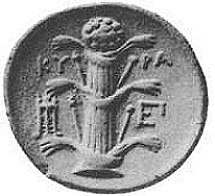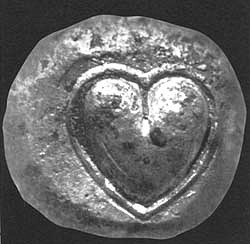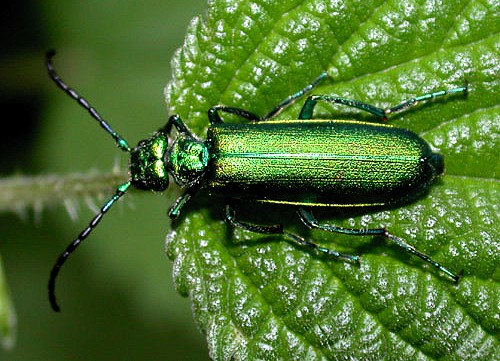Lessico
Silfio

Antica
moneta d'argento di Cirene
raffigurante uno stelo di silfio
Il silfio
(conosciuto anche come sílphion in greco o laser in latino) è
una pianta estinta appartenuta probabilmente al genere Ferula![]() (famiglia
Apiaceae o Ombrellifere). Cresceva in una ristretta zona costiera, di
circa 200 per 60 km, in Cirenaica
(famiglia
Apiaceae o Ombrellifere). Cresceva in una ristretta zona costiera, di
circa 200 per 60 km, in Cirenaica![]() (nell'attuale Libia). Considerato generalmente come una specie estinta di
"finocchio gigante" (anche se qualcuno ritiene che in realtà
appartenga alla specie non estinta Ferula tingitana), rappresentava un
tempo la maggiore risorsa commerciale dell'antica città di Cirene per il suo
utilizzo come spezia e medicinale. La pianta era così importante per
l'economia cirenaica che divenne il simbolo della città ed era rappresentata
in molte delle sue monete.
(nell'attuale Libia). Considerato generalmente come una specie estinta di
"finocchio gigante" (anche se qualcuno ritiene che in realtà
appartenga alla specie non estinta Ferula tingitana), rappresentava un
tempo la maggiore risorsa commerciale dell'antica città di Cirene per il suo
utilizzo come spezia e medicinale. La pianta era così importante per
l'economia cirenaica che divenne il simbolo della città ed era rappresentata
in molte delle sue monete.

Ferula tingitana
Secondo la
leggenda, la pianta era un dono del dio Apollo![]() .
Era ampiamente utilizzata dalla maggior parte delle antiche culture
mediterranee: i Romani la consideravano "valere il suo peso in denarii."
.
Era ampiamente utilizzata dalla maggior parte delle antiche culture
mediterranee: i Romani la consideravano "valere il suo peso in denarii."
Il
prodotto di valore era una resina (detta laser o laserpicium –
o laserpitium, che deriverebbe da lac = latte + sirpe
derivato attraverso l'etrusco dal greco sílphion) ricavata dalla
pianta. Veniva raccolta in maniera simile a Ferula assafoetida, una
pianta con proprietà simili al silfio, tanto che i Romani, compreso il
geografo Strabone![]() ,
usavano la stessa parola per descriverle entrambe.
,
usavano la stessa parola per descriverle entrambe.
A parte i
suoi usi nella cucina greco-romana (come ad esempio nelle ricette di Apicio![]() ),
la pianta era utilizzata per molte applicazioni mediche. Si diceva che poteva
essere usata per trattare la tosse, la gola irritata, la febbre,
l'indigestione, i dolori, le verruche e tutti i tipi di malattie. Ma
soprattutto, secondo Plinio il Vecchio
),
la pianta era utilizzata per molte applicazioni mediche. Si diceva che poteva
essere usata per trattare la tosse, la gola irritata, la febbre,
l'indigestione, i dolori, le verruche e tutti i tipi di malattie. Ma
soprattutto, secondo Plinio il Vecchio![]() ,
era utilizzata come contraccettivo. Oggi sappiamo che molte specie
appartenenti alla famiglia delle Apiaceae hanno proprietà estrogeniche,
ed è stato dimostrato che alcune (come la carota selvatica) possono fungere
da abortivo; è quindi possibile che la pianta fosse farmacologicamente attiva
per la prevenzione o l'interruzione della gravidanza.
,
era utilizzata come contraccettivo. Oggi sappiamo che molte specie
appartenenti alla famiglia delle Apiaceae hanno proprietà estrogeniche,
ed è stato dimostrato che alcune (come la carota selvatica) possono fungere
da abortivo; è quindi possibile che la pianta fosse farmacologicamente attiva
per la prevenzione o l'interruzione della gravidanza.
Estinzione
La ragione della presunta estinzione del silfio non è completamente chiara. Molte speculazioni si basano su di un presunto aumento della domanda di animali cresciuti nutrendosi della pianta, per dei presunti effetti sulla qualità della carne: il pascolo eccessivo combinato con un'eccessiva raccolta potrebbero aver provocato l'estinzione.
Il clima del Maghreb è andato progressivamente inaridendosi nel corso dei millenni, e la desertificazione potrebbe essere stata un altro fattore.
Un'altra
teoria punta il dito contro l'avidità dei governatori della provincia romana Creta
et Cyrene: la cosa sarebbe del tutto plausibile, visto che la corruzione
dei governatori romani era già stata documentata da Cicerone![]() :
nelle sue Verrinae contro Verre (ca. 119-43 aC, che ricoprì varie
cariche e si arricchì smodatamente). Dopo aver preso il potere dai coloni
greci che avevano governato Cirene democraticamente per secoli, i governatori
avrebbero cercato di massimizzare i profitti della loro provincia facendo
coltivare intensivamente il silfio, ma rendendo in questo modo il suolo
inadatto a ospitare la pianta selvatica cui si attribuiva il valore di
medicinale. Teofrasto
:
nelle sue Verrinae contro Verre (ca. 119-43 aC, che ricoprì varie
cariche e si arricchì smodatamente). Dopo aver preso il potere dai coloni
greci che avevano governato Cirene democraticamente per secoli, i governatori
avrebbero cercato di massimizzare i profitti della loro provincia facendo
coltivare intensivamente il silfio, ma rendendo in questo modo il suolo
inadatto a ospitare la pianta selvatica cui si attribuiva il valore di
medicinale. Teofrasto![]() dice che il tipo di Ferula che veniva specificamente chiamata "silfio"
aveva delle esigenze così particolari da crescere solo allo stato selvatico e
da non poter essere coltivata con successo su un terreno dissodato. La validità
di quest'affermazione è comunque dubbia, visto che Teofrasto stava
semplicemente citando una testimonianza di un'altra fonte.
dice che il tipo di Ferula che veniva specificamente chiamata "silfio"
aveva delle esigenze così particolari da crescere solo allo stato selvatico e
da non poter essere coltivata con successo su un terreno dissodato. La validità
di quest'affermazione è comunque dubbia, visto che Teofrasto stava
semplicemente citando una testimonianza di un'altra fonte.
J. S.
Gilbert, in una sua ipotesi, ritiene che il prodotto esportato (che era una
specie di gomma) non derivasse unicamente dalla pianta ma che vi fossero
miscelati anche degli intestini di insetto contenenti il composto chimico
cantaridina (principio attivo della cantaride![]() ,
Lytta vesicatoria). Per rendere il prodotto appetibile secondo i gusti
dei Greci, l'ingrediente derivato dall'insetto sarebbe stato tenuto segreto.
Quando i governatori romani presero il controllo della regione, per la
produzione del silfio avrebbero utilizzato il lavoro degli schiavi, che però
ignoravano il modo in cui il prodotto avrebbe dovuto essere preparato: poiché
non si riusciva più a ottenere la stessa qualità di un tempo, si pensò che
la vera pianta del silfio si fosse estinta. La cantaridina è tossica per
l'uomo, e un po' come per la Mentha pulegium
,
Lytta vesicatoria). Per rendere il prodotto appetibile secondo i gusti
dei Greci, l'ingrediente derivato dall'insetto sarebbe stato tenuto segreto.
Quando i governatori romani presero il controllo della regione, per la
produzione del silfio avrebbero utilizzato il lavoro degli schiavi, che però
ignoravano il modo in cui il prodotto avrebbe dovuto essere preparato: poiché
non si riusciva più a ottenere la stessa qualità di un tempo, si pensò che
la vera pianta del silfio si fosse estinta. La cantaridina è tossica per
l'uomo, e un po' come per la Mentha pulegium![]() ,
l'ingestione di una piccola quantità non ucciderebbe necessariamente un
adulto, ma potrebbe molto più facilmente uccidere un embrione in via di
sviluppo.
,
l'ingestione di una piccola quantità non ucciderebbe necessariamente un
adulto, ma potrebbe molto più facilmente uccidere un embrione in via di
sviluppo.
Simbologia
Ci sono
state alcune speculazioni sul nesso tra il silfio e la tradizionale simbologia
della forma del cuore ![]() .
.
La Chiesa cattolica ritiene che il simbolo del cuore fu utilizzato per la prima volta nel XVII secolo, quando Santa Margherita Maria Alacoque ebbe una visione di una forma di cuore dentro una corona di spine. A ogni modo, il simbolo è presente in vetrate molto più antiche. Il simbolo è piuttosto simile al geroglifico egizio utilizzato per indicare il concetto del cuore.
La natura sessuale di quel concetto, combinata con l'ampio uso del silfio nell'antico Egitto per il controllo delle nascite, e il fatto che i semi del silfio erano a forma di cuore, lascia pensare che il geroglifico possa essere derivato dalla forma del seme di silfio.
Il silfio d’oro reciso di Cirenaica
Nell’araldica militare italiana il silfio d’oro reciso di Cirenaica è il simbolo concesso alle unità che hanno combattuto nelle campagne in Africa settentrionale durante la seconda guerra mondiale.

Silphium perfoliatum
Con il nome di silfio si designa anche il genere Silphium, della famiglia Composite o Asteracee, proprio dell'America Settentrionale, e in particolare il Silphium perfoliatum, erbacea perenne alta fino a 2 m e oltre.

Ancient
silver coin from Cyrene
depicting a stalk of Silphium
Silphium (also known as sílphion in Greek or laser in Latin) was a plant of the genus Ferula. Generally considered to be an extinct "giant fennel" (although some claim that the plant is really Ferula tingitana), it once formed the crux of trade from the ancient city of Cyrene for its use as a rich seasoning and as a medicine. It was so critical to the Cyrenian economy that most of their coins bore a picture of the plant.

Ferula tingitana
Silphium was an important species in prehistory, as evidenced by the Egyptians and Knossos Minoans developing a specific glyph to represent the Silphium plant. The valuable product was the resin (laser, laserpicium, or lasarpicium) of the plant. It was harvested in a manner similar to asafoetida, a plant with similar enough qualities to silphium that Romans, including the geographer Strabo, used the same word to describe both.
Aside from its uses in Greco-Roman cooking (as in recipes by Apicius), many medical uses were ascribed to the plant. It was said that it could be used to treat cough, sore throat, fever, indigestion, aches and pains, warts, and all kinds of maladies. Chief among its medical uses, according to Pliny the Elder, was its role as a herbal contraceptive. Given that many species in the parsley family have estrogenic properties, and some (such as Wild carrot) have been found to work as an abortifacient, it is quite possible that the plant was pharmacologically active in the prevention or termination of pregnancy. Legend said that it was a gift from the god Apollo. It was used widely by most ancient Mediterranean cultures; the Romans considered it "worth its weight in denarii."
Extinction
The reason for silphium's extinction is not entirely known. The plant grew along a narrow coastal area, about 125 by 35 miles, in Cyrenaica (in present-day Libya). Much of the speculation about the cause of its extinction rests on a sudden demand for animals that grazed on the plant, for some supposed effect on the quality of the meat. Overgrazing combined with overharvesting may have led to its extinction. The climate of the Maghreb has been drying over the millennia, and desertification may also have been a factor. Another theory is that when Roman provincial governors took over power from Greek colonists, they over-farmed silphium and rendered the soil unable to yield the type that was said to be of such medicinal value. Theophrastus reports that the type of ferula specifically referred to as "silphium" was odd in that it only grew in the wild, but could not be successfully grown as a crop in tilled soil. The validity of this report is questionable, however, as Theophrastus was merely passing on a report from another source. Pliny reported that the last known stalk of silphium was given to the Emperor Nero "as a curiosity".

Ancient
silver coin from Cyrene
depicting a seed/fruit of Silphium
There has been some speculation about the connection
between silphium and the traditional heart shape ![]() .
.
The symbol is remarkably similar to the Egyptian "heart soul". The sexual nature of that concept, combined with the widespread use of silphium in ancient Egypt for birth control, and the fact that the seeds of silphium are shaped like a heart, leads to speculation that the character for Egyptian "heart soul" may have been derived from the shape of the silphium seed.
Contemporaneous writings help tie silphium to sexuality and love, as laserpicium makes an appearance in a poem of Catullus (Catullus 7) to his lover Lesbia. As well as in Pausanias', Description of Greece in which he says
"For it so happened that his maiden daughter was living in it. By the next day this maiden and all her girlish apparel had disappeared, and in the room were found images of the Dioscuri, a table, and silphium upon it."
Il silfio d’oro reciso di Cirenaica
In the Italian military heraldry Il silfio d’oro reciso di Cirenaica (silphium couped or of Cyrenaica) was the symbol granted to the units that fought in the campaigns in North Africa during World War II.
Cantaride deriva dal greco kantharís-ídos, diminutivo di kántharos, scarabeo (la cui etimologia greca è oscura), tramite il latino cantharis-idis. Lytta vesicatoria è il suo nome scientifico. Lytta deriva dal greco lýssa, in attico lýtta, che significa furore, frenesia, pazzia, provocata da un dio, ma secondo Plinio significa anche un verme sulla lingua del cane, ritenuto causa della rabbia (Naturalis historia XXIX 100: Est vermiculus in lingua canum, qui vocatur a Graecis lytta, quo exempto infantibus catulis nec rabidi fiunt nec fastidium sentiunt.). Vesicatoria ha un'etimologia troppo facile, ma che vale la pena specificare: la cantaridina contenuta nell'insetto è una sostanza con proprietà rubefacenti e vescicatorie.
Insetto coleottero della famiglia Meloidi, la cantaride è lunga sino a ca. 2,5 cm ed è caratterizzata da una bella livrea metallica verde-blu. Gli adulti della cantaride si nutrono delle foglie di diverse specie arboree; le larve, invece, si nutrono a spese delle larve degli Apidi, nonché delle loro provviste alimentari.
Dall'animale essiccato si ottiene una droga che ha lo stesso nome e il cui principio attivo è la cantaridina, sostanza con proprietà rubefacenti e vescicatorie. Ha odore caratteristico, sgradevole e sapore amaro pungente. Fu usata in passato come revulsivo locale e, per via orale, come afrodisiaco e abortivo, per la sua azione congestionante a carico degli organi pelvici.
La cantaridina può produrre gravi avvelenamenti, per la facilità del suo assorbimento cutaneo, già alla dose di 0,5-1 grammo di polvere di cantaridi. La sintomatologia è rappresentata da scialorrea, vomito, diarrea, dolori addominali, emicranie, convulsioni, proteinuria, cilindruria, ematuria. La terapia consiste nel lavaggio gastrico, nella somministrazione di apomorfina e per via sottocutanea di morfina, caffeina. Per completezza aggiungiamo che la cantaridina è chimicamente l'anidride interna o lattone dell'acido cantaridinico, HOC8H11(COOH)2 Viene usata sotto forma di pomata con le stesse indicazioni della droga in toto.

The Spanish fly is an emerald-green beetle in the family Meloidae, Lytta vesicatoria. It is 15 mm to 22 mm long and 5 mm to 8 mm wide, and lives on plants in the families Caprifoliaceae and Oleaceae. The beetle contains up to 5% cantharidin which irritates animal tissues. The crushed powder of Spanish fly is of yellowish brown to brown-olive color with iridescent reflections, of disagreeable scent and bitter flavor.
Spanish fly, or cantharides as it is sometimes called, is often given to farm animals to incite them to mate. The cantharides excreted in the urine irritate the urethral passages, causing inflammation in the genitals and subsequent priapism. For this reason, Spanish fly has been given to humans for purposes of seduction. It is dangerous since the amount required is minuscule and the difference between the effective dose and the harmful dose is quite narrow. Cantharides cause painful urination, fever, and sometimes bloody discharge. They can cause permanent damage to the kidneys and genitals.
History
Its medical use dates back to descriptions from Hippocrates. Plasters made from wings of these beetles have been used to raise blisters. In ancient China, cantharides beetles were mixed with human dung, arsenic and wolfsbane to make the world's first recorded stink bomb. It is also one of the world’s most well-known aphrodisiacs.
In Roman times, Livia, the scheming wife of Augustus Caesar, would slip it into food hoping to inspire her guests to some indiscretion with which she could later blackmail them. Henry IV (1050-1106) is known to have consumed Spanish fly at the risk of his health. In 1572, the famous French surgeon Ambroise Paré wrote an account of a man suffering from "the most frightful satyriasis" after having taken a potion composed of nettles and cantharides.
In the 1670s, Spanish fly was mixed with dried moles and bat's blood for a love charm made by the black magician La Voisin. It was slipped into the food of Louis XIV to secure the king's lust for Madame de Montespan. In the 18th century cantharides became fashionable, known as pastilles Richelieu in France. Marquis de Sade is claimed to have given aniseed-flavored pastilles that were laced with Spanish fly to prostitutes at an orgy in 1772. He was sentenced to death for poisoning and sodomy, but later reprieved on appeal.
Also it was used as an abortifacient, stimulant (since one of its effects was producing insomnia and nervous agitation), and as a poison; in powder, mixed with the food, it could go unnoticed. Aqua toffana, or aquetta di Napoli, was one of the poisons associated with the Medicis. Thought to be a mixture of arsenic and cantharides, it was reportedly created by an Italian countess, Toffana. Four to six drops of this poison in water or wine was enough to deliver a painless death in a few hours.
In order to determine if a death had taken place by the effects of Spanish fly they had to resort to the vesicación test. One of those test methods consisted of rubbing part of the internal organs of the deceased, dissolved in oil, on the shaved skin of a rabbit; the absorption of the cantharides and its blistering effect are such that they became visible on the skin of the rabbit.
Commercial products
Cantharides are illegal in the United States, except for use in animal husbandry and by licensed physicians for the topical treatment of certain types of warts. Some internet or mail order suppliers of sex stimulants advertise such products like "Herbal Spanish fly", "Mexican Spanish Fly", or "Spanish Fly Potion". Most of these products are simply cayenne pepper in capsules, sometimes blended with the powder of ginseng, kelp, ginger or gotu kola. The products with the name "Spanische Fliege (Spanish fly)" that are available in Germany represent no danger with a normal application since they contain the active substance actually only in homeopathic dosage, diluted to be effectively non-existent.
Culinary use
Dawamesk, a spread or jam made in North Africa and containing hashish, almond paste, pistachio nuts, sugar, orange or tamarind peel, cloves and other various spices, occasionally included Spanish fly. In Morocco and other parts of North Africa, a spice blend called Ras el hanout included cantharides in its list of ingredients at one time. However, the sale of Spanish fly in the Moroccan spice markets was banned in the 1990s.